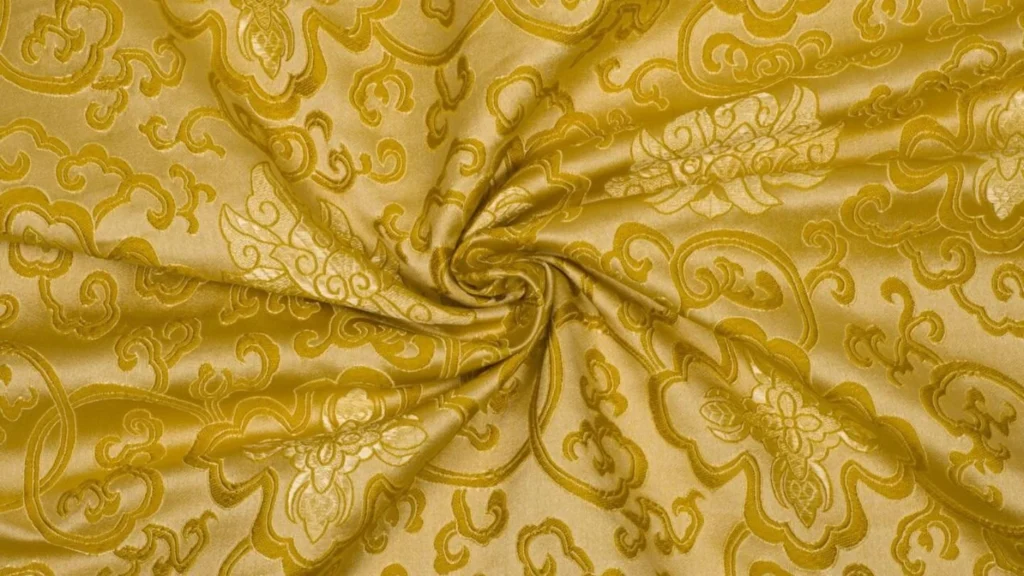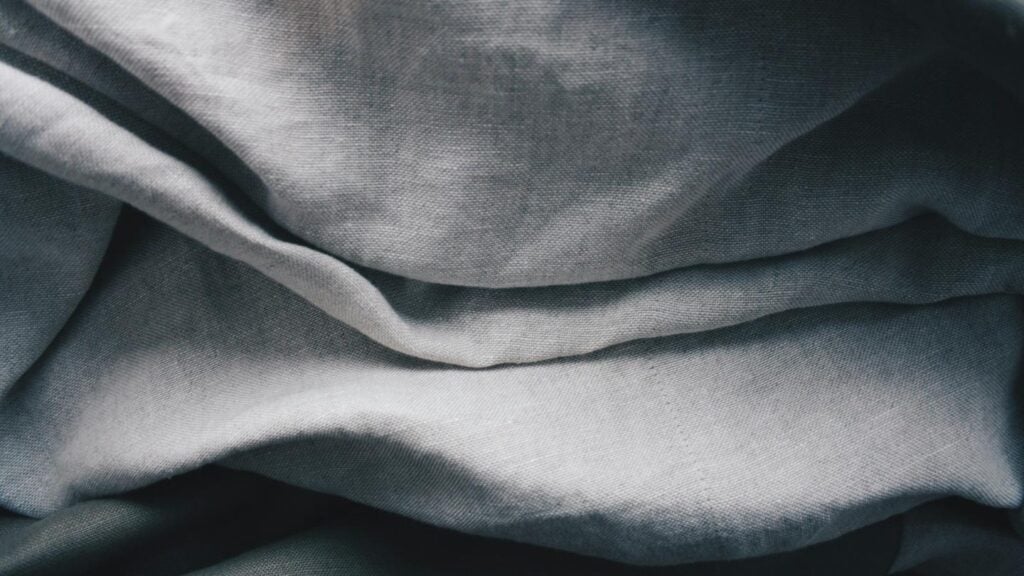2 – Benefits of Choosing Jute Fabric
3 – Jute Fabric vs Other Fabrics
4 – How Jute Fabric Is Manufactured
5 – Common Uses in Fashion
6 – Understanding the Environmental Impact of Jute Fabric
7 – Exploring Price Points and Value for Money
8 – Conclusion
9 – FAQs
What is Jute Fabric?
Jute fabric is a strong, coarse, and eco-friendly textile made from the fibers of the jute plant—a tall, leafy plant primarily grown in warm, humid climates. Known as the “golden fiber” due to its natural golden-brown hue, jute is one of the most affordable and widely used natural fibers in the world, second only to cotton.

Key Features of Jute Fabric
- Texture: Coarse and rustic feel (though it can be softened for apparel use)
- Appearance: Earthy, natural golden color that takes dyes well
- Breathability: Good airflow, making it comfortable for use in warm climates
- Durability: High tensile strength and resistance to wear, ideal for heavy-use items
- Biodegradability: Fully compostable and environmentally friendly
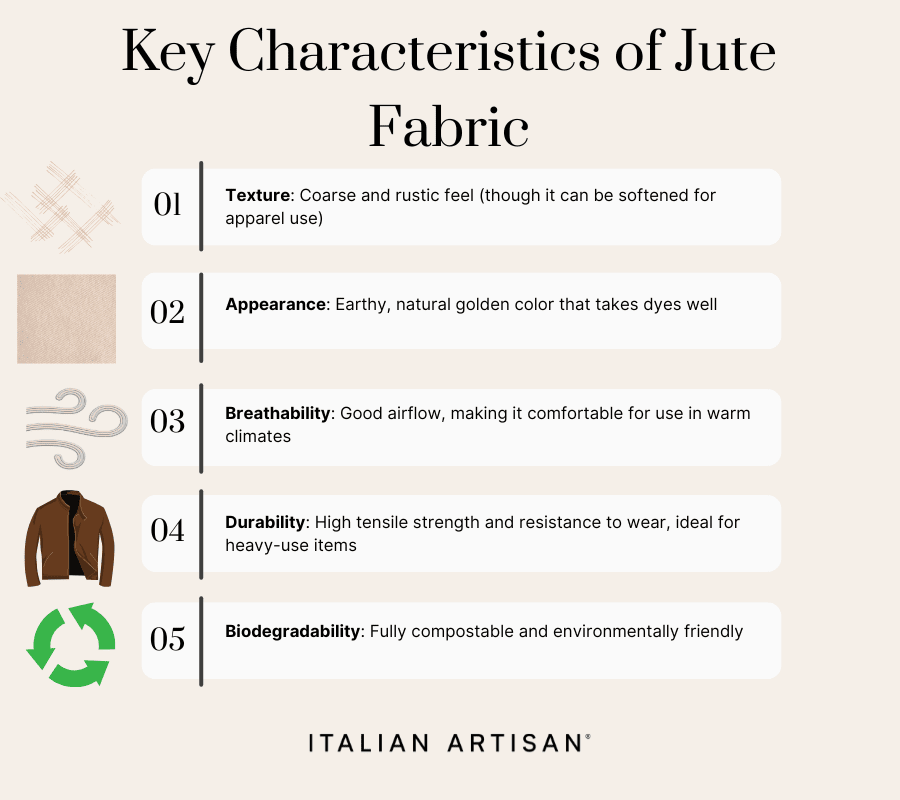
What is Jute Fabric Made of?
Jute fabric is composed of cellulose (plant-based material) and lignin (a wood-like fiber), giving it a unique combination of softness and strength. The fibers are extracted from the outer layer of the plant’s stalk, typically through a process called retting, where the stalks are soaked in water to loosen the fibers before extraction and weaving.
Jute is often associated with products like burlap sacks or tote bags, but advancements in processing have pushed it into fashion, upholstery, and even blended textiles. It is valued for being a low-impact fiber, requiring minimal pesticides and water, and offering a biodegradable alternative to synthetic materials.

Benefits of Choosing Jute Fabric
Choosing jute fabric isn’t just a style decision—it’s a commitment to sustainability, durability, and value. As more brands and consumers seek eco-friendly alternatives, jute stands out for its unique blend of practical and environmental advantages.
Eco-Friendly by Nature
- Jute is 100% biodegradable and compostable, making it an ideal choice for reducing plastic and synthetic waste.
- It requires minimal water, pesticides, or fertilizers to grow, unlike cotton, which is more resource-intensive.
- The jute plant absorbs large amounts of CO₂ and releases oxygen, contributing to better air quality during cultivation.
Affordable and Abundant
- Jute is one of the most affordable natural fibers available. Its widespread cultivation keeps costs low without sacrificing quality.
- It’s accessible for both large-scale production and smaller, artisanal applications.
Durable and Long-Lasting
- Jute has a naturally high tensile strength, making it resistant to wear, pressure, and stretching.
- This makes it perfect for reusable products like shopping bags, rugs, or upholstery fabrics.
Breathable and Anti-Static
- It allows air to circulate easily, making it comfortable for warm climates.
- Jute does not retain static electricity, which helps prevent dust attraction—a plus for interior fabrics and fashion items.
Aesthetic Appeal
- With its natural, earthy tones and textured surface, jute fabric adds an organic charm to any item.
- It blends easily with other materials like cotton or silk for a more refined look in apparel or home décor.
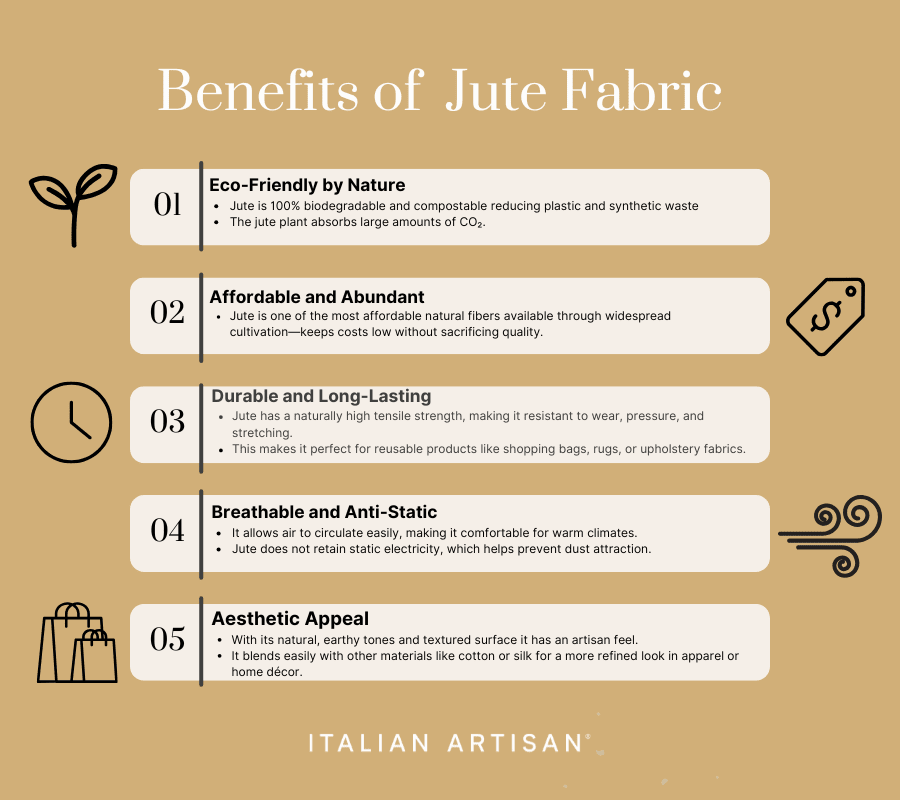
Consumer insight:
Customers who value sustainability often cite the look and feel of jute as a key reason for their purchase—its rustic texture is authentic and timeless. Additionally, its sustainability resonates strongly, especially among younger buyers and environmentally conscious brands.
Jute Fabric vs Other Fabrics
Jute fabric stands out among natural and synthetic textiles for its sustainability, strength, and affordability. But how does it compare to other commonly used fabrics like cotton, linen, and polyester?
Jute vs Cotton
Both are plant-based fibers, but while cotton is soft and ideal for garments worn close to the skin, it requires high amounts of water and pesticides to cultivate. Jute, on the other hand, grows with minimal environmental impact. It’s not as soft as cotton, but it is significantly more durable and better suited for items like bags, upholstery, and rugs.
Jute vs Linen
Linen, derived from flax, is breathable and has a crisp texture favored in summer clothing and home textiles. Like jute, it’s biodegradable and eco-friendly, but it is more expensive and less durable under heavy use. Jute is coarser but far more cost-effective, making it a better option for sturdy and practical applications.
Jute vs Polyester
Polyester is a synthetic fiber made from petroleum, prized for its elasticity, wrinkle resistance, and low price. However, it’s non-biodegradable and sheds microplastics, raising serious environmental concerns. Jute, while less flexible, is a natural and compostable alternative that aligns with the principles of circular fashion and sustainable design.
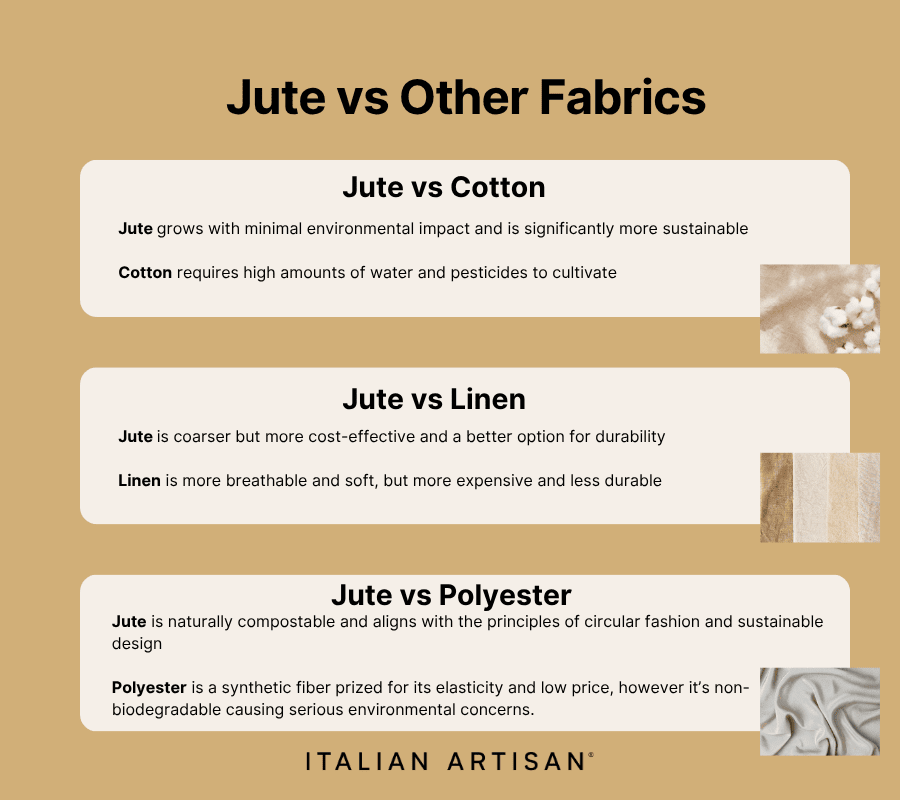
In Summary:
- Jute is more sustainable than cotton or polyester, and more affordable than linen.
- It is stronger and more durable, though coarser in texture. These products may sacrifice some softness but will provide a sturdier product that will last longer while costing less to make, contributing to its sustainable integrity.
- Best used in functional products like bags, home textiles, and accessories where strength and eco-impact matter more than softness.
How Jute Fabric Is Manufactured
The journey of jute fabric begins in the fertile, humid plains, where the jute plant thrives. The manufacturing process transforms this fast-growing crop into a durable, biodegradable textile through a series of traditional yet efficient steps.
- Cultivation
Jute is a rain-fed crop that grows rapidly in warm, humid climates with little need for fertilizers or pesticides. It’s usually harvestable within 4–6 months, making it one of the most sustainable crops in terms of land and water use. - Retting
After harvesting, the stalks are bundled and soaked in water—usually in rivers or ponds—for several days. This process, called retting, allows the natural bacteria in water to break down the plant’s outer layers and loosen the fibers. - Stripping and Washing
Once retted, the fibers are stripped from the stalk by hand, then washed to remove impurities. This manual process is labor-intensive but essential for ensuring the quality of the final fabric. - Drying
The washed fibers are laid out in the sun to dry completely. At this stage, they appear golden and coarse—earning jute its nickname, the “golden fiber.” - Spinning
Once dried, the fibers are spun into coarse yarn using traditional spinning wheels or industrial machines. The yarn may be treated to soften it, depending on the final application. - Weaving or Knitting
The spun jute yarn is woven into fabric using looms. The weave can range from very coarse to finer textures, especially when blended with other fibers like cotton. - Finishing
Depending on the end use, jute fabric may undergo treatments such as dyeing, lamination, or blending to improve softness, water resistance, or visual appeal.

Modern Innovations:
While much of the process still uses traditional methods, innovations like enzyme retting and mechanical processing are being explored to reduce labor and improve fiber quality—making jute more accessible to fashion and interior designers looking for refined finishes.
The Result?
A low-impact, high-resilience textile with deep cultural roots and growing global relevance. The simplicity of the jute manufacturing process is part of its charm: minimal machinery, no chemical-heavy treatments, and a durable rustic fabric.
Common Uses in Fashion
Though jute was traditionally used for industrial purposes like sacks, ropes, and carpets, its role in fashion has grown significantly in recent years—thanks to the increasing demand for sustainable and natural materials. Designers and brands are reimagining jute not just as a utilitarian fabric, but as a canvas for creativity and conscious style.
- Bags and Accessories
Jute is widely used in tote bags, handbags, clutches, and even wallets. Its coarse texture and earthy appearance give these items a raw, artisanal feel. Many brands use it for eco-friendly shopping bags and promotional items, often combining it with leather or canvas for added appeal. - Footwear
Espadrilles and sandals often feature jute soles or woven uppers, thanks to the fiber’s durability and breathability. The natural grip of jute makes it a practical and stylish choice for casual summer footwear. - Outerwear and Structured Pieces
While jute isn’t typically used for soft garments like T-shirts, it’s increasingly featured in structured clothing—jackets, vests, and even corsets—often blended with cotton or wool to soften its texture while retaining its distinct aesthetic. - Hats and Headwear
Jute’s stiffness makes it ideal for sun hats and caps. These accessories maintain shape well and offer a rustic alternative to straw or synthetic fibers. - Trims, Labels, and Embellishments
Jute is also used in small fashion details such as garment tags, appliqués, and trims. It adds a tactile, handmade quality that aligns with slow fashion values.

Why Fashion Brands Choose Jute
- It aligns with sustainability goals and appeals to eco-conscious consumers.
- It conveys an earthy, artisanal identity that stands out in a crowded market.
- It is versatile in texture and finish—ranging from raw to refined when blended or treated.

Understanding the Environmental Impact of Jute Fabric
Jute is often hailed as one of the most environmentally friendly textiles available today—and for good reason. From cultivation to disposal, it has a remarkably low ecological footprint compared to many other natural and synthetic fabrics. For brands and consumers seeking more sustainable fashion choices, jute offers a powerful combination of biodegradability, renewability, and carbon capture.
Here’s How Jute Stands Out Environmentally:
- Low Water Usage
Unlike cotton, which requires thousands of liters of water per kilogram produced, jute grows almost entirely on rainfall. This makes it particularly suitable for regions with limited water resources and reduces strain on freshwater ecosystems. - Minimal Chemical Inputs
Jute requires very little fertilizer or pesticide, significantly lowering the risk of soil degradation, groundwater contamination, and harm to local biodiversity, ultimately protecting the environment from damages - High Carbon Sequestration
Jute plants absorb large amounts of carbon dioxide—more than many trees—during their rapid growth cycle. One hectare of jute cultivation can absorb up to 15 tons of CO₂ and release 11 tons of oxygen in a single season. - Soil Health and Crop Rotation
Jute is often grown in rotation with rice, helping improve soil structure and fertility. Its deep roots loosen compacted soil, enhancing drainage and aeration naturally. - Biodegradable and Compostable
At the end of its life, jute decomposes completely without leaving toxic residues. It can return to the soil as organic matter, unlike synthetic fabrics that persist for hundreds of years. - Reduced Textile Waste
As a strong, durable material, jute products are often reused many times before disposal—especially in the case of bags and packaging—contributing to a circular product lifecycle.
Exploring Price Points and Value for Money
Jute fabric is widely recognized as one of the most cost-effective natural fibers on the market. Its affordability, combined with its durability and sustainability, makes it an attractive choice for both emerging designers and established brands looking to balance budget and ethics. The filaments are stretched to align the molecules, which increases strength and elasticity.
- Abundant supply
Jute is cultivated on a large scale where favorable growing conditions and long-standing expertise ensure consistent, high-volume yields. This abundance keeps prices stable and accessible. - Low production costs
The plant requires little irrigation, no synthetic fertilizers, and minimal energy for processing. Most steps, like retting and drying, rely on natural resources (water and sunlight), which significantly reduces operational costs. - Local labor and infrastructure
In regions where jute is grown, the manufacturing ecosystem is well-developed, with generations of skilled artisans and low labor costs helping to keep final prices down—without compromising on authenticity.
Cost vs other fabrics:
- Jute is cheaper than linen, more sustainable than cotton, and far more ethical than polyester, especially when long-term use and end-of-life disposal are considered.
- While high-end blends of jute (e.g. jute-cotton or jute-silk) may come at a slightly higher price, they still offer excellent value compared to luxury textiles with similar strength and texture. Also providing a more ecologically friendly and sustainable option.
Value for Money
- Durability: Jute lasts longer than many cheaper synthetic fabrics, reducing the need for frequent replacement.
- Sustainability: Lower carbon impact and zero-waste disposal add “invisible value” from an environmental and brand positioning perspective.
- Versatility: From budget-friendly tote bags to artisanal home decor, jute adapts to a range of price points and design uses.
- Storytelling power: For brands, using jute adds a meaningful narrative around sustainability and local craftsmanship—important elements that resonate with modern consumers.
Produce your fashion collection with us
Conclusion
Jute fabric meets the demands of providing natural materials for modern design while staying true to environmental values. Jute offers a reliable and responsible alternative to synthetic and resource-heavy fabrics. Useful for diverse products, it provides excellent value for money— allowing sustainable options to not come at a cost for quality or aesthetics.
FAQs
1. What is Jute fabrics used for?
Jute fabrics are used for bags, rugs, clothes, home decor, and eco-friendly packaging.
2. Why are Jute fabrics considered eco-friendly?
They are made from natural plants, need little water or chemicals to grow, and break down easily in nature.
3. Where do Jute fabrics come from?
Jute fabrics mostly come from warm and humid climates, where the jute plant grows well.
4. What are the main Jute fabrics properties?
They are strong, coarse, breathable, biodegradable, and have a naturally earthy golden tone.
5. Who uses Jute fabrics the most today?
Eco-conscious brands, fashion designers, and home decor makers use them for sustainable products.
6. How are Jute fabrics made?
They are made by soaking the plant, taking out the fibers, drying them, and weaving them into fabric.
7. What makes Jute fabrics different from cotton or polyester?
They are rougher but stronger, cheaper, and much better for the environment.
8. Why should I choose Jute fabrics over other materials?
Because they’re natural, strong, low-cost, and help reduce waste that is harmful to the earth.
9. Will Jute fabrics last a long time?
Yes, they are very durable, especially when used for bags, upholstery, or decor.
10. How can I tell if a product is made from real Jute fabrics?
It feels rough and natural, looks golden or earthy, and may be labeled as jute or burlap.




